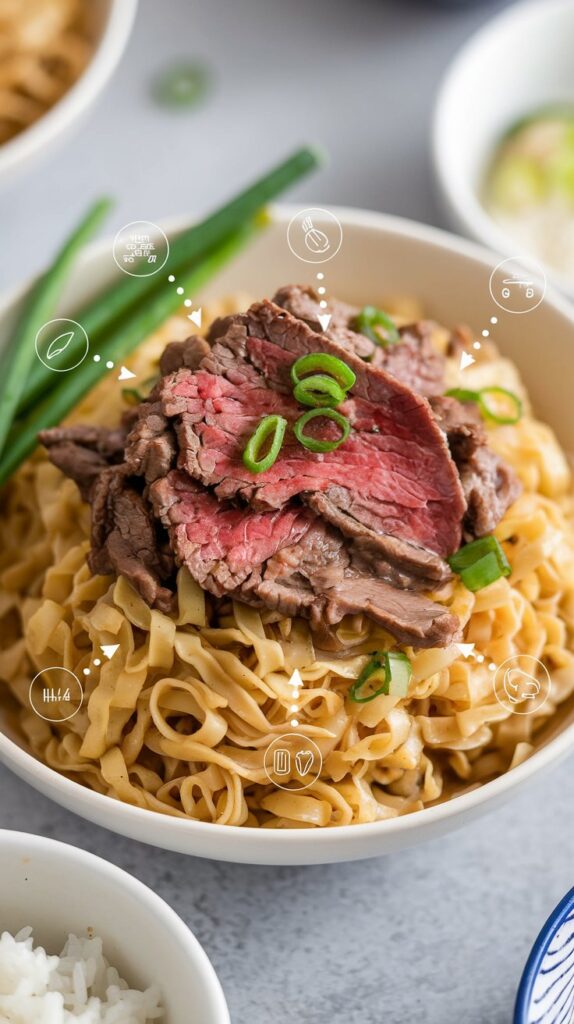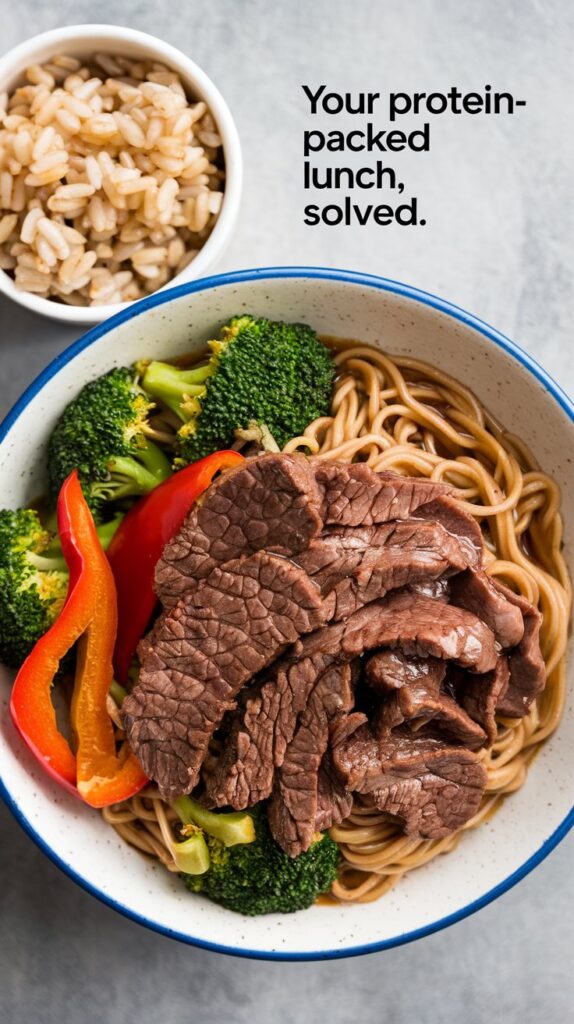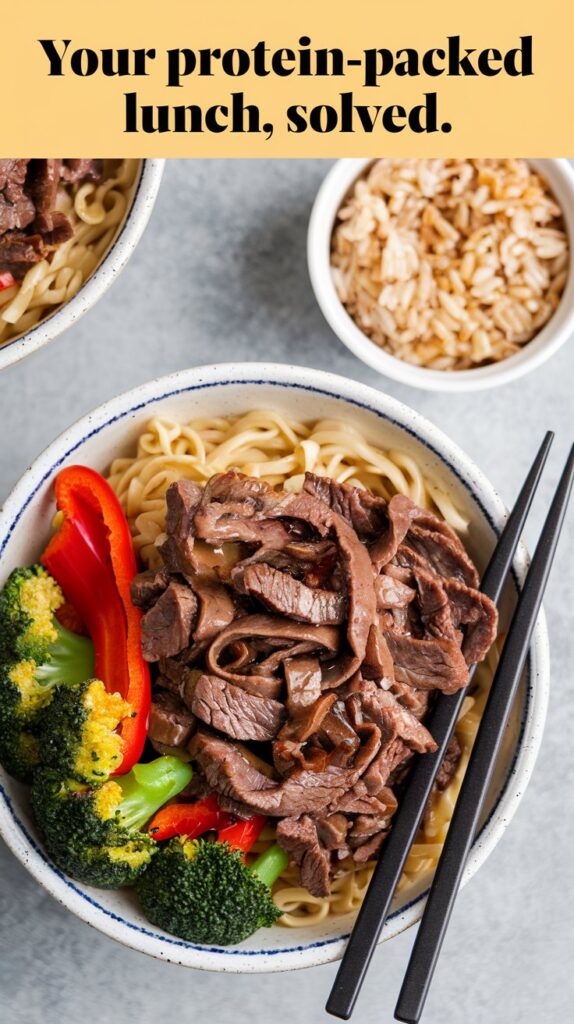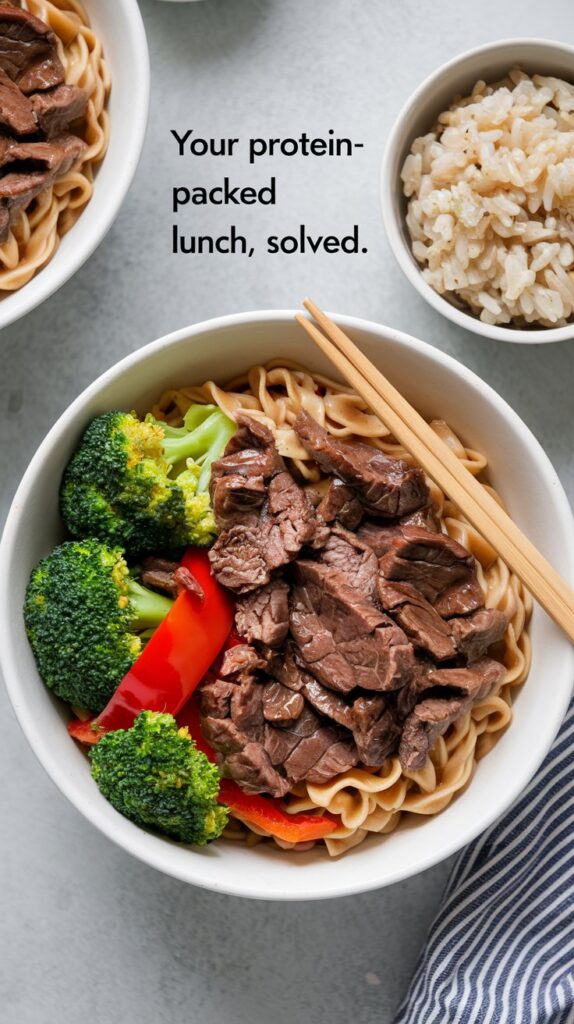Mongolian beef noodles are a delicious dish that provides not only great flavor but also high-protein benefits integral to a balanced diet. This dish typically features tender slices of beef paired with noodles and an array of vegetables, delivering both satisfaction and nourishment. Let’s explore why high-protein Mongolian beef noodles are an excellent choice for your meals.
The main star of this dish is beef, which is famous for being rich in protein. Protein plays a significant role in building and repairing tissues, and it’s essential for making enzymes and hormones. Including protein in your meals can help you feel fuller for longer, which makes it an ideal addition to a balanced diet.
Each serving of Mongolian beef noodles can contain a substantial amount of protein, depending on the meat used. Here’s a quick breakdown:
| Type of Beef | Protein per 100g |
|---|---|
| Sirloin | 26g |
| Flank Steak | 28g |
| Chuck Roast | 24g |
Whether you choose sirloin or flank steak, you are guaranteed a meal packed with protein. This is especially beneficial for active individuals or those looking to maintain muscle mass. this into your diet can also support weight management, as protein can help regulate appetite and reduce cravings.
Another aspect to consider is the balance of carbohydrates. The noodles in this dish provide the necessary carbohydrates your body needs for energy. It’s essential to combine high-protein foods like beef with carbohydrates, especially if you lead an active lifestyle. Whole grain noodles can further enhance the nutritional profile by adding fiber, which supports digestion.
Vegetables are often included in a Mongolian beef noodles recipe, which enhances the meal’s health benefits. These can include bell peppers, carrots, and green onions, maximizing your intake of vitamins and minerals. This blend not only provides more nutrients but also adds vibrant colors and flavors to your plate.
When preparing Mongolian beef noodles, the method of cooking also contributes to the overall healthiness of the dish. Quick stir-frying helps retain the nutrients in vegetables and keeps the meat juicy. Cooking with a moderate amount of healthy oils, like olive or sesame oil, helps maintain a balanced approach to the meal.
Here’s a simple recipe to get you started:
- Ingredients:
- 250g beef (your choice of cut)
- 200g noodles (preferably whole-grain)
- 1 cup mixed vegetables (bell peppers, carrots, etc.)
- 3 tablespoons soy sauce
- 1 tablespoon olive or sesame oil
- 2 cloves garlic, minced
- 1 teaspoon ginger, minced
- Instructions:
- Cook noodles according to package instructions. Drain and set aside.
- In a pan, heat the oil and sauté garlic and ginger until fragrant.
- Add beef slices and cook until browned.
- Stir in mixed vegetables and continue to cook for a few minutes.
- Add soy sauce and mix well.
- Combine with noodles, mixing thoroughly before serving.
Enjoying high-protein Mongolian beef noodles can ultimately help you achieve your nutritional goals. For more recipes and dietary advice, visit Eat Right and explore the wealth of information they provide for maintaining a balanced diet.
By opting for this vibrant dish, you’re not only choosing flavor but also investing in your health. With its blend of protein, carbohydrates, and vegetables, Mongolian beef noodles stand out as a wholesome meal option that satisfies both the palate and the body.
For a deeper dive into the benefits of a protein-rich diet, check out Bodybuilding.com. They provide extensive resources and articles that empower you to make informed dietary decisions.
Step-by-Step Guide to Preparing Mongolian Beef Noodles
Are you ready to enjoy a delicious and satisfying meal? Let’s prepare some mouth-watering Mongolian beef noodles! This dish is not only flavorful but also offers a balanced approach to dining, making it perfect for any occasion. Follow this step-by-step guide to create a delightful dinner that’s both nutritious and filling.
Gather Your Ingredients
Before you start cooking, ensure you have the right ingredients. Here’s what you will need:
- 1 pound flank steak, thinly sliced
- 8 ounces of egg noodles or any noodles of your choice
- 3 tablespoons soy sauce
- 2 tablespoons oyster sauce
- 2 tablespoons brown sugar
- 2 cloves garlic, minced
- 1 teaspoon ginger, minced
- 1 bell pepper, sliced
- 2 green onions, chopped
- 2 tablespoons sesame oil
- Salt and pepper, to taste
Step 1: Marinate the Beef
To enhance the flavor of the flank steak, marinate it first. In a bowl, mix 2 tablespoons of soy sauce and a pinch of salt and pepper. Add the sliced beef and let it marinate for about 20-30 minutes. This step helps to tenderize the meat and infuses it with flavor.
Step 2: Cook the Noodles
While the beef is marinating, cook your noodles according to the package instructions. You want them to be nice and al dente. Once cooked, drain the noodles and set them aside. A tip here is to toss them with a little sesame oil to prevent sticking.
Step 3: Stir-Fry the Beef
In a large skillet or wok, heat 1 tablespoon of sesame oil over medium-high heat. Once it’s hot, add the marinated beef in batches to avoid overcrowding the pan. Stir-fry for about 3-4 minutes until the beef is browned and cooked through. Remove the beef from the skillet and set it aside.
Step 4: Sauté the Vegetables
In the same skillet, add a bit more sesame oil if necessary. Toss in the minced garlic and ginger, sautéing them for about 30 seconds until fragrant. Then, add the sliced bell pepper and cook for an additional 2-3 minutes, or until they soften slightly. This will bring out the natural sweetness of the veggies.
Step 5: Combine Everything
Now it’s time to bring your dish together! Add the cooked noodles back into the skillet along with the sautéed vegetables. Pour in the remaining soy sauce, oyster sauce, and brown sugar. Mix everything well to ensure the noodles are fully coated in the sauce. Add the beef back to the skillet, stirring to combine all the ingredients uniformly.
Step 6: Garnish and Serve
Your high-protein Mongolian beef noodles are almost ready! Once everything is heated through, sprinkle chopped green onions on top for added flavor and color. Serve this delicious dish warm, and enjoy the blend of savory beef, tender noodles, and vibrant vegetables.
Nutrition Information
| Nutrient | Per Serving |
|---|---|
| Calories | 450 |
| Protein | 35g |
| Carbohydrates | 50g |
| Fat | 15g |
Enjoying Mongolian beef noodles can be a fulfilling experience, especially when you know you’re making a balanced meal. For more tasty recipes and cooking tips, check out Simply Recipes or Serious Eats. Happy cooking!
Alternative Ingredients for Healthier Mongolian Beef Noodles
Cooking healthy meals can be a challenge, especially when it comes to popular dishes like Mongolian beef noodles. These savory delights are often loaded with calories and unhealthy fats. Thankfully, there are plenty of alternative ingredients you can use to create a healthier version without sacrificing flavor. By substituting a few key components, you can cook up a delicious recipe that still keeps the indulgent spirit of the original dish alive.
Lean Protein Options
The primary component of Mongolian beef is, of course, beef. However, you can choose healthier protein sources without losing the essence of the dish. Consider swapping traditional cuts of beef with one of the following alternatives:
- Bison: A leaner option than beef, bison is rich in protein and lower in calories.
- Chicken Breast: Skinless chicken breast offers a similar texture while being lower in fat.
- Tofu: For a plant-based option, firm tofu absorbs flavors well and is an excellent source of protein.
Healthy Noodle Substitutes
The noodles in Mongolian beef dishes are usually high in refined carbs. Switching to more nutritious noodles can elevate your meal’s health profile. Here are some excellent options:
- Whole Wheat Noodles: These contain more fiber than regular noodles and provide greater satiety.
- Zucchini Noodles: For a low-carb alternative, spiralized zucchini adds freshness and crunch to your dish.
- Brown Rice Noodles: They offer a nutty flavor and are a gluten-free choice.
Flavorful Sauces with Fewer Calories
Traditional Mongolian beef sauce can be high in sugar and sodium. Here’s how you can make it healthier:
- Low-Sodium Soy Sauce: Reducing your sodium intake is essential; opt for low-sodium soy sauce to cut down on the salt.
- Honey or Maple Syrup: Instead of using sugar, try natural sweeteners to enhance the flavor while keeping it wholesome.
- Rice Vinegar: A splash of rice vinegar adds acidity without too many calories, enhancing the dish’s overall flavor.
Fresh Vegetables for Added Nutrition
Vegetables are a vital part of any balanced meal. a variety of colorful veggies will not only boost the nutritional value but also the visual appeal of your dish. Here are some great options:
- Bell Peppers: Rich in vitamins and add a sweet crunch.
- Broccoli Florets: A fiber-packed option that pairs beautifully with beef or alternatives.
- Carrots: They add natural sweetness and are high in beta-carotene.
- Snap Peas: Crunchy and full of vitamins, they complement Mongolian beef noodles perfectly.
Making the Most of Seasonings
Seasonings can elevate the taste of your dish without adding calories or unhealthy ingredients. Instead of store-bought seasoning mixes high in sodium, try these options:
- Garlic and Ginger: These fresh ingredients offer amazing flavor and health benefits.
- Sesame Oil: A little goes a long way; it provides a distinct taste and healthy fats.
- Green Onions: For a burst of flavor, sprinkle chopped green onions on top before serving.
By substituting these ingredients, you can create a healthier version of Mongolian beef noodles that still satisfies your cravings. Not only do these alternatives help lower calories and fats, but they also introduce a range of nutrients essential for a balanced meal. For whether you’re looking to maintain your health or simply want a delicious meal, these adjustments can make all the difference.
For further insights on healthy recipe substitutions, visit Eating Well or explore more alternatives at Healthline.
Meal Prep Ideas Featuring High-Protein Mongolian Beef Noodles
If you’re looking for a nutritious and delicious meal prep idea, high-protein Mongolian beef noodles should be at the top of your list. This dish is packed with flavor and nutrients, making it an excellent choice for anyone wanting to eat healthily without sacrificing taste. By incorporating high-quality protein, vibrant vegetables, and wholesome noodles, you can create a balanced meal that keeps you satisfied throughout the day. The following ideas will help you master the art of meal prepping with Mongolian beef noodles.
Choosing Your Ingredients
The key to a successful high-protein Mongolian beef noodles recipe lies in selecting the right ingredients. Here’s what you’ll need:
- Beef: Opt for lean cuts like flank steak or sirloin. They are rich in protein and lower in fat.
- Noodles: Use whole-wheat or rice noodles for a healthier option. They provide carbs and additional fiber.
- Vegetables: Incorporate bell peppers, broccoli, and snap peas for nutrients and vibrant color.
- Sauce: A mix of soy sauce, hoisin sauce, garlic, and ginger will enhance the flavors.
- Sesame oil: A small amount adds a lovely aroma and taste to the dish.
Meal Prep Steps
Here’s how to prepare and store your Mongolian beef noodles for the week:
- Marinate the Beef: Combine the beef slices with soy sauce, minced garlic, and ginger. Let it marinate for at least 30 minutes. This step enhances flavor and tenderness.
- Cook the Beef: Heat some sesame oil in a pan over medium-high heat. Stir-fry the marinated beef until it’s nicely browned. This should take about 3-4 minutes.
- Add Vegetables: Toss your chosen vegetables into the pan and stir-fry until they’re crispy yet tender. This usually takes around 4-5 minutes.
- Prepare Noodles: While the beef and veggies are cooking, prepare your noodles according to the package instructions. Drain and set aside.
- Combine All Ingredients: Add the cooked noodles to the beef and vegetable mixture. Pour in hoisin sauce and mix well until everything is evenly coated. Allow it to simmer for a minute.
- Portion and Store: Divide the meal into individual containers. Store them in the refrigerator for up to 5 days. Reheat when you’re ready to eat.
Nutrition Breakdown
| Nutrient | Amount per Serving |
|---|---|
| Calories | 450 |
| Protein | 30g |
| Carbohydrates | 50g |
| Fat | 10g |
| Fiber | 5g |
This nutritional breakdown ensures you’re consuming a balanced meal that supports your dietary goals. Adjust the portions according to your specific needs.
Tips for Success
Here are a few extra tips to make your meal prep more effective:
- Batch Cook: Make a double batch of the recipe to save time during the week.
- Freeze Portions: If you won’t consume all the meals within a week, freeze some for future use.
- Experiment with Flavors: Feel free to add in other proteins like chicken or tofu, or try different sauces to keep things interesting.
- Include Sides: Add a side of edamame or a fresh salad to enhance your meal.
High-protein Mongolian beef noodles are not only satisfying but also a breeze to prepare for meal prep. Try different variations and enjoy a nutritious meal throughout the week. For more recipes and tips, check out Serious Eats and Food Network. Eating healthy has never been easier or tastier!
Pairing Sides and Drinks with High-Protein Mongolian Beef Noodles
High-Protein Mongolian Beef Noodles are a delicious and hearty meal perfect for any occasion. The savory taste of the beef combined with the flavorful noodles creates a dish that can stand out on its own. However, pairing this tasty entree with the right sides and drinks elevates the overall dining experience. Let’s explore some fantastic options that will complement your high-protein dish.
Satisfying Side Dishes
When choosing sides for High-Protein Mongolian Beef Noodles, you want to find options that balance the rich flavors of the beef while also adding nutritional value. Here are some ideas:
- Steamed Vegetables: Broccoli, carrots, and snap peas are excellent choices. They offer a crunch that contrasts beautifully with the tenderness of the beef and noodles.
- Garlic Fried Rice: A bowl of garlic fried rice can add a delightful aroma and complement the dish’s flavor. It’s a great source of carbohydrates to help keep you full.
- Asian Slaw: A zesty coleslaw made with cabbage, carrots, and a sesame-soy dressing adds a refreshing crunch to your meal.
- Edamame: This high-protein snack is not only delicious but also easy to prepare. Simply steam and sprinkle with a little sea salt for an excellent protein-packed side.
- Sweet Potato Fries: Baked sweet potato fries provide a sweet contrast to salty beef, and they are rich in vitamins and fiber.
Perfect Drink Pairings
Selecting the right beverage can enhance the flavors of your meal. Here are some drink options that pair well with High-Protein Mongolian Beef Noodles:
- Green Tea: This traditional drink is not only hydrating but also helps to cleanse your palate between bites. Consider a hot or iced variant for a refreshing touch.
- Asian Pear Juice: The sweetness of Asian pear juice balances the savory notes of the beef, creating a delightful contrast. Plus, it’s a wonderful way to add more nutrients to your meal.
- Light Beer: A crisp lager complements flavored dishes without overpowering them. It can enhance the overall experience and is a great casual pairing.
- Sparkling Water with Lime: For a non-alcoholic option, sparkling water with a splash of lime is refreshing and helps cleanse your palate.
- Chardonnay: If you prefer wine, a chilled Chardonnay can offer a great pairing. Its buttery notes and acidity match well with the dish’s richness.
Creating a Balanced Meal
To ensure your High-Protein Mongolian Beef Noodles are part of a balanced meal, be mindful of the proportions and nutritional content of what you serve alongside it.
| Food Item | Protein (g) | Carbohydrates (g) | Fat (g) |
|---|---|---|---|
| Mongolian Beef Noodles (1 serving) | 35 | 60 | 15 |
| Steamed Broccoli (1 cup) | 3 | 6 | 0 |
| Garlic Fried Rice (1 cup) | 5 | 45 | 8 |
| Edamame (1/2 cup) | 8 | 8 | 4 |
| Sparkling Water (12 oz) | 0 | 0 | 0 |
When you create a meal, aim for a balance of protein, carbs, and fats to keep your palate excited. Each of the available sides and drinks can enhance the overall enjoyment of your High-Protein Mongolian Beef Noodles.
Additionally, if you’re looking for more tips on preparing Mongolian dishes or finding authentic recipes that suit your taste, you can explore resources like Mongolian Food or Asian Food Network for inspiration. Pairing these delicious sides and drinks will not only make the meal more enjoyable but also healthier.
Key Takeaway:
Key Takeaway: Crafting a Delightful and Nutritious High-Protein Mongolian Beef Noodles Meal
The High-Protein Mongolian Beef Noodles recipe stands out not just for its tantalizing flavors but also for its significant health benefits. this dish into your balanced diet provides essential protein, which is crucial for muscle development and maintenance. With lean beef as the star ingredient, supplemented by vegetables and flavorful sauces, this meal becomes a powerhouse of nutrition. The protein helps keep you full, while the noodles offer quick energy, making it an excellent choice for athletes or anyone leading an active lifestyle.
Preparing Mongolian Beef Noodles is straightforward. Following a simple step-by-step guide can transform your kitchen into a culinary haven. Start with marinating the beef to infuse it with flavor, then stir-fry it at high heat to achieve a perfect sear. Add vegetables such as bell peppers, carrots, and broccoli to enhance the dish’s nutritional profile and color. The easy-to-follow cooking process ensures that even novice cooks can achieve delightful results without any fuss.
For those looking to take a healthier route, substituting traditional ingredients can make a world of difference. Opt for whole grain noodles instead of refined ones, as they are higher in fiber and provide sustained energy. Additionally, consider using alternative proteins, such as tofu or chicken, which can also pack a protein punch while catering to various dietary preferences.
Meal prepping with High-Protein Mongolian Beef Noodles is a fantastic idea for busy weekdays. Cook a large batch over the weekend and divide it into individual portions for lunches and dinners. This not only saves time but also guarantees that you have a nourishing meal ready to go.
Don’t forget to complement your High-Protein Mongolian Beef Noodles with delicious sides and refreshing drinks. Pairing them with a fresh salad or steamed vegetables boosts your intake of vitamins and minerals. A light fruit-infused water or iced tea can provide a perfect balance of hydration and flavor.
By embracing the versatile nature of High-Protein Mongolian Beef Noodles and experimenting with ingredients and pairings, you can enjoy a delightful, nutritious meal that supports your overall health and well-being. Whether you’re feeding a family or prepping meals for one, this recipe is guaranteed to satisfy both the palate and the nutritional needs.
Conclusion
Embracing a high-protein Mongolian beef noodles recipe brings numerous benefits to your balanced diet. With the right balance of protein, carbohydrates, and healthy fats, these noodles serve as a satisfying and nutritious meal. Following the step-by-step guide simplifies the cooking process, making it accessible for anyone, regardless of their culinary skills.
Exploring alternative ingredients can help you create healthier versions of this delicious dish. By swapping out certain components, like opting for lean cuts of beef or incorporating whole-grain noodles, you can boost the nutritional profile without sacrificing taste. These smart choices encourage a more balanced diet while keeping the flavors you love.
Meal prep becomes effortless with high-protein Mongolian beef noodles. Cooking in batches not only saves you time but also ensures that you have a nutritious meal ready at your fingertips throughout the week. It’s a practical way to stay committed to your health goals, even on the busiest days.
Pairing your dish with the right sides and drinks enhances the overall dining experience. Fresh vegetables can add a pleasing crunch, while a refreshing beverage can elevate the flavors. Whether you opt for steamed broccoli, a simple salad, or a light ginger tea, these combinations complement your high-protein meal beautifully.
By making these mindful choices regarding ingredients, preparation, and accompanying sides, you can enjoy a balanced, high-protein meal that satisfies your taste buds while nourishing your body.









Leave a Reply